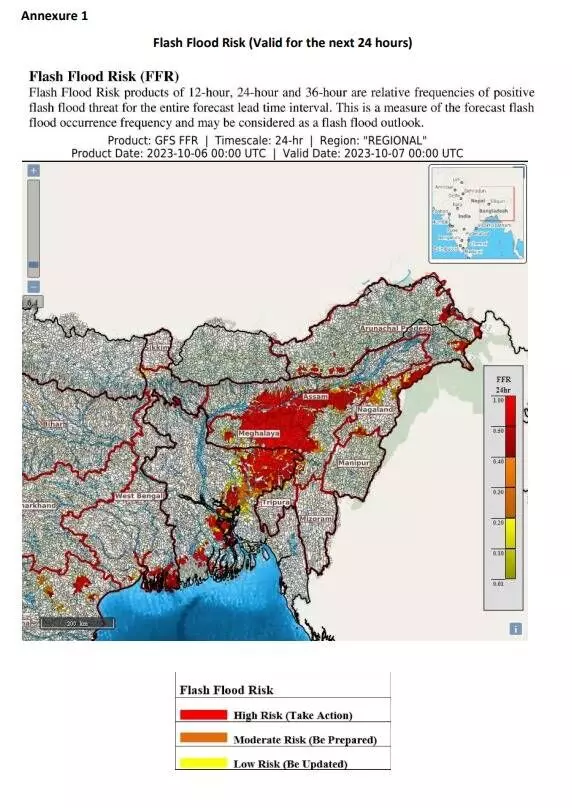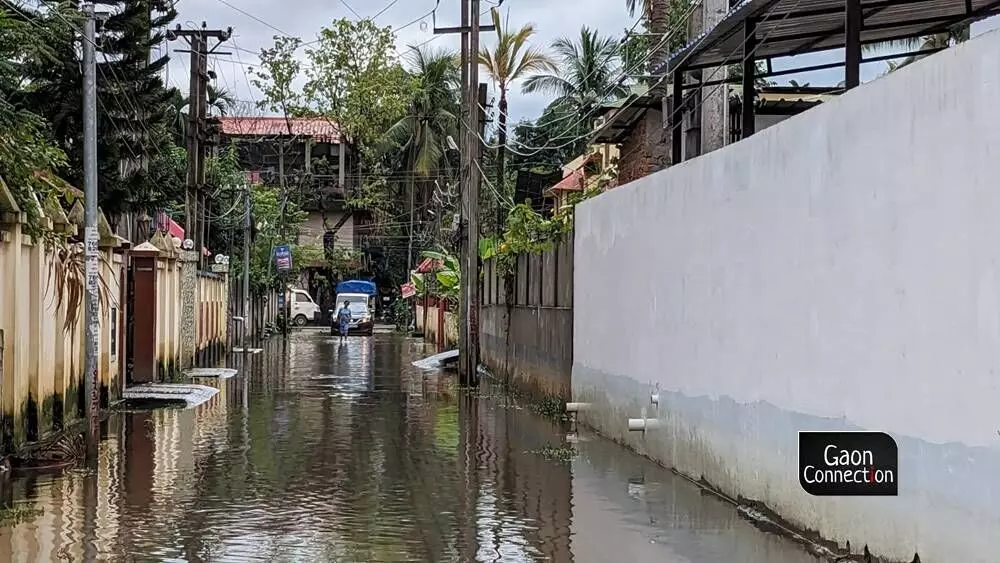Guwahati, Assam
The southwest monsoon season officially ended on September 30 last month, but incessant rains in the northeastern state of Assam have caused flash floods in Guwahati with several areas in the city knee-deep in water.
“Banpanit rickshaw solabo bohut kosto hoe [it is very difficult to ride the rickshaw in floods],” Bipin Das, in his 70s, told Gaon Connection. Das pulls a rickshaw to earn a livelihood in the city and complained that rainy days were the worst for the residents. Incessant rainfall inevitably causes flash floods, disrupting not merely his source of livelihood but also damaging property. And such instances of urban floods were the rise in the northeastern city.
“I have been working here for the last 45 years and I must say the city has changed drastically, especially in the last ten to fifteen years. Earlier flash flood issues were less but now the situation is completely different and difficult,” the rickshaw puller added.
Das is amongst hundreds of people affected by the flash floods that hit the city yesterday, October 6. The floods are being blamed on heavy rainfall in a short span of time. As per the Regional Meteorological Centre in Guwahati, the city recorded 167.80 millimetres (mm) of rainfall in two days.
The heavy rainfall that began on October 3 and lasted till the morning October 4, inundated prime locations and major roads within Guwahati, including Zoo Road, Rajgarh, Chandmari, Pub Sarania, Bhangagarh, and Satgaon. The India Meteorological Department (IMD) has issued a flood warning for Guwahati till today.
In the last 48 hours, Guwahati has received 167.80mm of rainfall. In comparison, we had 171.00mm rainfall in the entire month of September.
The receding of water was also delayed due to several trees falling in the Bharalu River, which have decreased the outflow of rainwater… pic.twitter.com/07u9xhqv4Z
— Ashok Singhal (@TheAshokSinghal) October 6, 2023
Sunit Das, a scientist working at the Regional Meteorological Centre in Guwahati informed Gaon Connection that the situation is likely to improve in the next 48 hours.
Natural Drainage Disrupted
An intricate network of rivers and beels (wetlands) forms the natural drainage system of Guwahati city on the banks of the Brahmaputra river. Last few decades, these water bodies have been encroached upon, thereby contributing towards an increased incidence of urban flooding. The Bahini-Bharalu, Guwahati’s main river, carries a large chunk of untreated sewage and empties it into the Brahmaputra river.
“In the last decade, flash floods in Guwahati have increased in intensity,” Digambar Patowary, a resident of Pub Sarania locality, told Gaon Connection.
“The primary cause of massive floods is the city’s flawed drainage system. Despite being located at the city’s heart, areas like Rajgarh, Chandmari, and Pub Sarania are perennially plagued by floods due to inadequate drainage,” Patowary added.
He urged the Guwahati Municipal Corporation (GMC) and Guwahati Metropolitan Development Authority (GMDA) to take immediate actions to solve this crisis.
Partha Prawal Goswami, another resident from the Zoo Road area, echoed these concerns, and said, “Floods in Guwahati are a recurring problem, and successive governments have failed to address the issue. Even citizens share some blame, as they neglect to keep drains and water outlets clean. Moreover, unplanned construction in the city exacerbates the problem.”

The location of Guwahati is like a saucer surrounded by hills around it. A 2016 research article published in the Journal of Ecosystem & Ecography has documented various hills in the city. “The central part of the city has small hillocks namely Sarania hill (193 m), Nabagrah hill (217 m), Nilanchal hill (193 m) and Chunsali hill (293 m). The Buragosain Parbat in the East and the hills of Rani and Garbhanga in the south form the major hill formations of the city. These hills make contiguous formations with the hills of Meghalaya. There are a total of 18 hills in the city,” reads the paper.
Because of its location, Guwahati is naturally prone to flash floods because runoff gushes down the hills and reaches the city in no time. However, the city also has a natural system of rivers and beels to drain the excess water into the Brahmaputra. But, in the last few decades, as the city has expanded, it has eaten into these water bodies and urban flooding has increased.
Another July 2014 report titled ‘Review of Studies on Urban Floods in Guwahati,’ prepared by the Ahmedabad-based All India Disaster Mitigation Institute, highlighted that Guwahati lacks a well-planned drainage system.
Residents also point out that paddy fields in and around Guwahati, which used to hold excess rainwater, have now been built over with no room for water to flow.
‘Mission Flood Free Guwahati’
The Assam government launched the ambitious ‘Mission Flood Free Guwahati’ in July, last year. This mission entrusts various agencies, including the Guwahati Metropolitan Development Authority, Water Resources Department, Public Works Department, and Guwahati Municipal Corporation, with distinct responsibilities aimed at mitigating the city’s flooding woes.
The mission encompasses desilting rivers and rivulets, maintaining existing feeder drains through cleaning, removing garbage and blockages, constructing new drains, establishing roads with side drains and culverts for improved drainage, and enforcing rainwater management structures in newly constructed buildings, as per building bye-laws.
Talking about the floods in the city, Anjan Sarma, a Guwahati-based independent expert in urban development explained that Guwahati is not a planned city and there is no strict enforcement of the available master plan.
“Therefore, we hardly see any land use regulation in the city, promoting mixed land use. Due to the haphazard and unplanned development in the city, the open spaces, water bodies are either encroached or developed to be used as residential or commercial areas resulting in flash floods or water stagnation,” Sarma told Gaon Connection.
“Even our hills are now encroached and vegetations are getting removed for construction of houses which is adding to the increased velocity of water to the city drains depositing lots of silt,” he added.

An intricate network of rivers and beels (wetlands) forms the natural drainage system of Guwahati city on the banks of the Brahmaputra river.
The expert opined that with the increase in concrete cover in the city, the water absorption has decreased and runoff velocity increases. Urban runoff is defined as surface runoff of rainwater inside the ground due to gravity.
“Also in the last few years, there has been severe encroachment of natural streams and water bodies. The width of Bharalu and Bahini river which runs in the middle of the city has been reduced drastically. This problem of flash flood is likely to incasrease further in the coming days if we don’t take steps to increase green cover in hills, increase water retention capacity of the city or increase carrying capacity of the natural streams,” he added.
Addressing urban flooding
According to Sarma, in the current scenario, the city authority can focus on how quickly the water can be subsided at the earliest and this can give some quick relief to the citizens from the fear of getting submerged.
Though residents are questioning the authorities and the government for not addressing the poor drainage system, Sarma, however, is of the view that the common people are equally responsible for the condition.
“ It is the public who settled encroaching water bodies and hills and depositing garbage in the drains. Citizens are also required to be equally responsible to stop flash floods along with the authority implementing strict enforcement of land regulation and protecting natural water bodies,” he said.


















